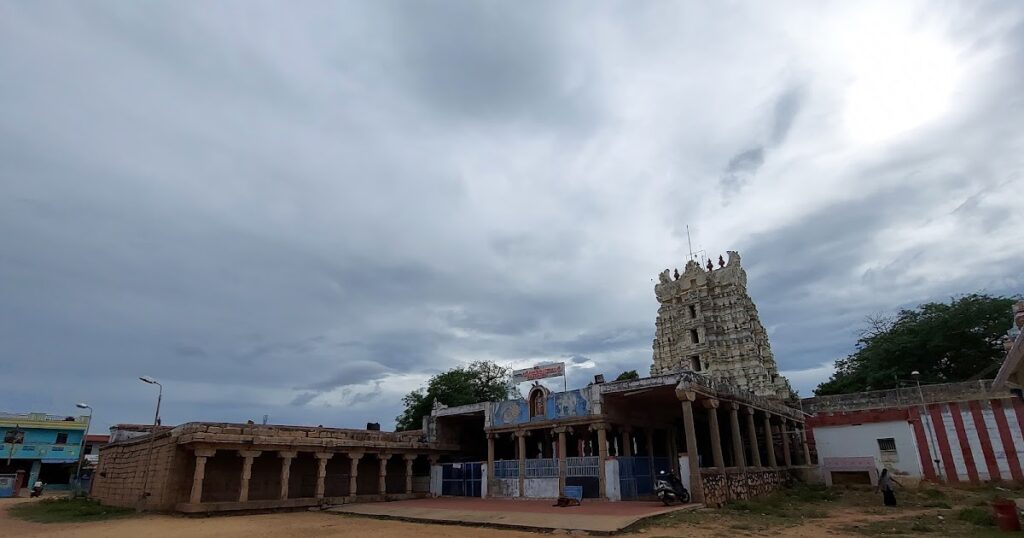About 13 kilometers from Tirunelveli lies the temple town of Krishnapuram, home to the architecturally resplendent Venkatachalapati Temple. While the temple is celebrated for its masterfully carved Nayaka-period sculptures, it also holds immense value as a historical and epigraphical site. A closer look at the stone inscription and five copper plates preserved within the temple reveals fascinating details about its origin, administration, and endowments.
In this 12th episode, we set aside the sculptural exploration and turn to the historical narrative—as told through inscriptions dated to the 16th century CE, supported by copper plate grants and early literary references.
.jpg) |
| Krishnapuram Temple |
🗿 Stone and Copper Plate Inscriptions
The temple has:
-
Two Tamil stone inscriptions engraved on the wall of the central shrine.
-
Five copper plate grants, primarily in Sanskrit and Nandināgari script, offering rich details about land grants, religious activities, and political patronage.
🔹 Inscription A.R. No. 16 of 1912
Located on the right wall of the central sanctum, this much-damaged record is attributed to Vijayanagara king Śrīraṅgadeva Mahārāya (1578–1586 CE). It mentions a grant by Virappa Nayaka (1573–1595 CE), in memory of his father Krishnappa Nayaka (1563–1573 CE), for the merit of his Kaśyapa gotra lineage.
The grant was made to the Tiruvēṅkaṭanātha temple at Krishnapuram, located on the banks of the Tāmraparṇi River. The inscription references the Tiruvadi dēśam, the geographical region to which the temple belonged.
Sidenote: Virappa Nayaka was the ruler of the region after Krishnappa Nayaka and continued to support the temple through charitable acts.
🔹 Inscription A.R. No. 17 of 1912
Found on the left wall of the same shrine, this record belongs to Vijayanagara king Vīraśrī-Sadāśivadeva Mahārāya (dated to Śaka 1485 or 1563 CE). It details the donation of villages to the temple by Krishnappa Nayaka, including:
These regions were granted to support the temple rituals and are said to have been acquired as amaranāyakam (service tenure lands) from Rāmarājar Ayyan, one of the top commanders of the Vijayanagara Empire.
🔹 Copper Plates (Sanskrit, Nandināgari script)
Known as the Krishnapuram Plates, this record is a royal grant issued by Sadāśiva Rāya, ruler of the Vijayanagara Empire, on the request of Krishnappa Nayak of Madura.
It confirms the grant of several villages to the Tiruvēṅkaṭanātha temple, dated to Śaka 1489, new moon day in the month of Puṣya, year Prabhava (1567 CE).
Sidenote: “These inscriptions are documented in Epigraphia Indica, Vol. IX, pp. 328–42.
🏛️ Historical Legacy of Krishnapuram Temple
It is clear from these inscriptions and copper plates that the temple was built and significantly expanded during the rule of Krishnappa Nayaka (1563–1572 CE), son of Viswanatha Nayaka, the founder of the Madurai Nayak dynasty.
Key contributions of Krishnappa Nayaka include:
-
Building the main sanctum and soaring gopuram.
-
Laying four processional streets around the temple for the temple car (ratha) festival.
-
Patronizing the establishment of an Agraharam with 108 Brahmin families skilled in Vedic and Agamic traditions to ensure continuous religious activity.
(Sidenote: The original name of the village was Thiruvenkatapuram, later changed to Krishnapuram in his honor.)
🧾 Literary and Historical References
An important figure associated with the temple’s construction is Deivachillayar (Mayilerum Perumal), son-in-law of Viswanatha Nayak’s minister. His contributions are recorded in:
These works describe Deivachillayar’s deep involvement in temple construction and administration under Krishnappa Nayaka’s reign.
🌾 Temple Economy and Ritual Support
The temple’s economic base was strengthened by donations from the Nayak rulers:
-
Six villages—Ariyakulam, Kodikulam, Kuthukaval, Puthaneri, Pottukalam, and Sriramakulam—were granted for daily nitya pūja performance.
-
Additional grants were made for:
These inscriptions illustrate a comprehensive ecosystem of temple management, land revenue, and ritual continuity—reflecting a well-administered sacred institution.
The stone and copper plate inscriptions of Krishnapuram offer far more than names and dates—they bring to life a story of visionary rulers, devoted patrons, and an enduring cultural legacy that continues to shine alongside its world-class sculpture.
In the next episode, we will return to our sculptural exploration with the remaining parts of the temple.
Happy travelling.
This is Part 12 of the series of articles on Krishnapuram Temple. If you are interested to read the earlier parts of the series, click the links below.
Part 1
Part 2
Part 3
Part 4
Part 5
Part 6
Part 7
Part 8
Part 9
Part 10
Part 11

